
The common linnet is a small passerine bird of the finch family, Fringillidae. It derives its common name and the scientific name, Linaria, from its fondness for hemp seeds and flax seeds—flax being the English name of the plant from which linen is made.

Linaria is a genus of 150 species of flowering plants, one of several related groups commonly called toadflax. They are annuals and herbaceous perennials, and the largest genus in the Antirrhineae tribe of the plantain family Plantaginaceae.
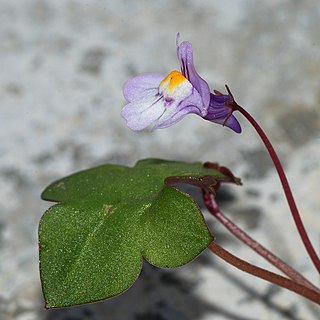
Cymbalaria is a genus of about 10 species of herbaceous perennial plants previously placed in the family Scrophulariaceae, but recently shown by genetic research to be in the much enlarged family Plantaginaceae.

Nuttallanthus is a genus of four species of herbaceous annuals and perennials that was traditionally placed in the foxglove family Scrophulariaceae. Due to new genetic research, it has now been placed in the vastly expanded family Plantaginaceae. Three species of Nuttallanthus are native to North America and one to South America. Nuttallanthus was until the 1980s included in a wider circumscription of the genus Linaria, a genus now considered restricted to the Old World.

Nectar guides are markings or patterns seen in flowers of some angiosperm species, that guide pollinators to their rewards. Rewards commonly take the form of nectar, pollen, or both, but various plants produce oil, resins, scents, or waxes. Such patterns also are known as "pollen guides" and "honey guides", though some authorities argue for the abandonment of such terms in favour of floral guides. Pollinator visitation can select for various floral traits, including nectar guides through a process called pollinator-mediated selection.

Linaria vulgaris is a species of toadflax (Linaria), native from Europe to Siberia and Central Asia. It has also been introduced and is now common in North America.

Nuttallanthus canadensis, the blue toadflax, Canada toadflax, or old-field toadflax, is a species of Nuttallanthus in the family Plantaginaceae, native to eastern North America from Ontario east to Nova Scotia and south to Texas and Florida.

Daviesia, commonly known as Bitter-peas, is a large genus of flowering plants in the legume family. They are native to Australia, with a centre of diversity in Western Australia.
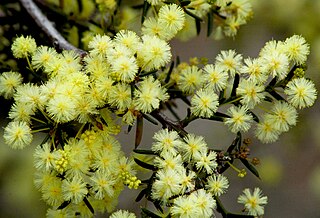
Acacia genistifolia, commonly known as spreading wattle or early wattle is a species of Acacia in the family Fabaceae that is native to south eastern Australia.
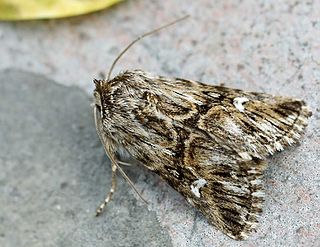
Calophasia lunula is a Palearctic species of noctuid moth known by the common names toadflax moth and toadflax brocade moth.

Eteobalea intermediella is a moth of the family Cosmopterigidae. It is native to an area ranging from Central and Southern Europe, east to the Caucasus, Asia Minor, the Near and Middle East towards Central Asia. It is also present in North Africa. It has been introduced to the United States and Canada.

Linaria maroccana is a species of flowering plant in the plantain family known by the common names Moroccan toadflax and annual toadflax. It is native to Morocco, but it can be found elsewhere growing wild as an introduced species, such as California. It is a readily available ornamental plant for the flower garden. This is an annual herb growing erect to approach a maximum height of 50 cm (20 in), its stem with linear leaves 2–4 cm (0.8–1.6 in) long. The inflorescence is a raceme of flowers occupying the top of the stem. At the base of each flower is a calyx with five narrow, pointed lobes. The flower is 2–4 cm (0.8–1.6 in) long with five lobes arranged into two lips with a spur at the end. The flower is often purple in color with white near the throat, but flowers of many different colors are bred for the garden. Dwarf cultivars are also available.

Linaria purpurea is a species of flowering plant in the plantain family known by the common name purple toadflax. It is native to Italy, but it can be found growing wild as an introduced species in parts of western North America, including California, western Washington, and British Columbia, and it is cultivated as an ornamental plant. It is a perennial herb growing 30 to 70 centimeters tall with linear leaves 2 to 5 centimeters in length. The inflorescence is a raceme of flowers occupying the top of the stem. The flower is between 1 and 2 centimeters long with five lobes arranged into two lips with a spur at the end. The flower is usually light to medium purple in color. This plant is poisonous to livestock, the larvae of some species of Lepidoptera use this plant as a food source.
HMS Linaria was a Flower-class corvette of the Royal Navy, which saw service during the Second World War. Originally built for the US Navy as Clash (PG-91), formerly CN-309, she was launched on 18 November 1942, by Midland Shipyards, Ltd., Midland, Ontario, Canada. Upon completion Clash was transferred to the Royal Navy on 19 June 1943, and commissioned as HMS Linaria. On 27 July 1946, she was returned to the US Navy. Never commissioned in the US Navy, Clash was sold on 15 January 1948 for commercial use and reportedly renamed Porto Offuro.
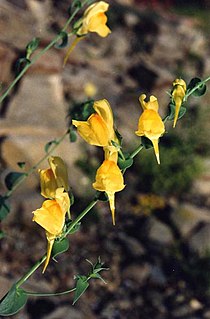
Linaria dalmatica is a herbaceous plant native to western Asia and southeastern Europe that has become a weed in other areas. Its common names include Balkan toadflax, broadleaf toadflax, and Dalmatian toadflax.
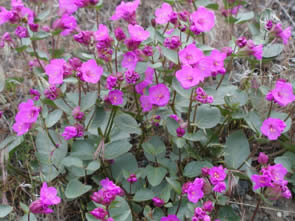
Mirabilis macfarlanei is a rare species of flowering plant in the four o'clock family known by the common name MacFarlane's four o'clock. It is native to Idaho and Oregon in the United States, where it is only known from three river canyons. It faces a number of threats and is federally listed as a threatened species of the United States.

The Antirrhineae are one of the 12 tribes of the family Plantaginaceae. It contains the toadflax relatives, such as snapdragons. They are probably most closely related to the turtlehead tribe (Cheloneae) and/or a large and badly resolved core group of their family including plants as diverse as water-starworts (Callitriche), foxgloves (Digitalis), and speedwell (Veronica). The Antirrhineae include about 30 genera with roughly 320 species, of which 150 are in genus Linaria. The type genus is AntirrhinumL.

Nanorrhinum scoparium, synonym Kickxia scoparia, is a species of flowering plant in the family Plantaginaceae.

Linaria repens, also known as pale toadflax or creeping toadflax in Europe and as striped toadflax in the US, is an herbaceous plant in the family Plantaginaceae, native to Europe.
Rhinusa pilosa is a species of true weevil in the family of beetles known as Curculionidae. It is found exclusively on Linaria vulgaris Mill. (Plantaginaceae), also known as common or yellow toadflax where it creates a gall on the plant's stem, and was found originally in Serbia. R. pilosa has been introduced in the United States and Canada as an biocontrol agent to control L. vulgaris.
















